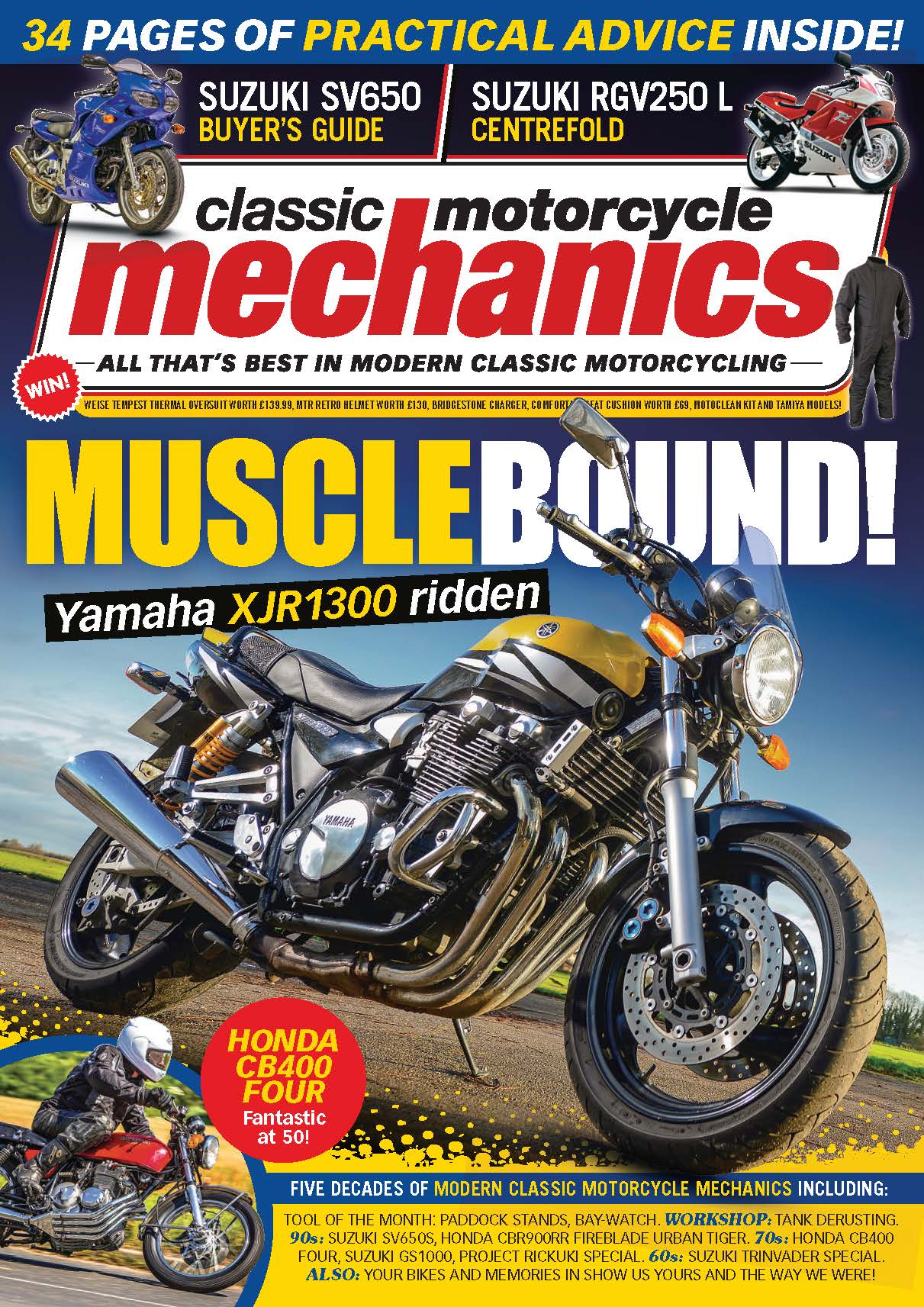Big, bad-ass, British and brilliant – the immense Triumph Rocket III is now 20 years old and as beefy as ever…
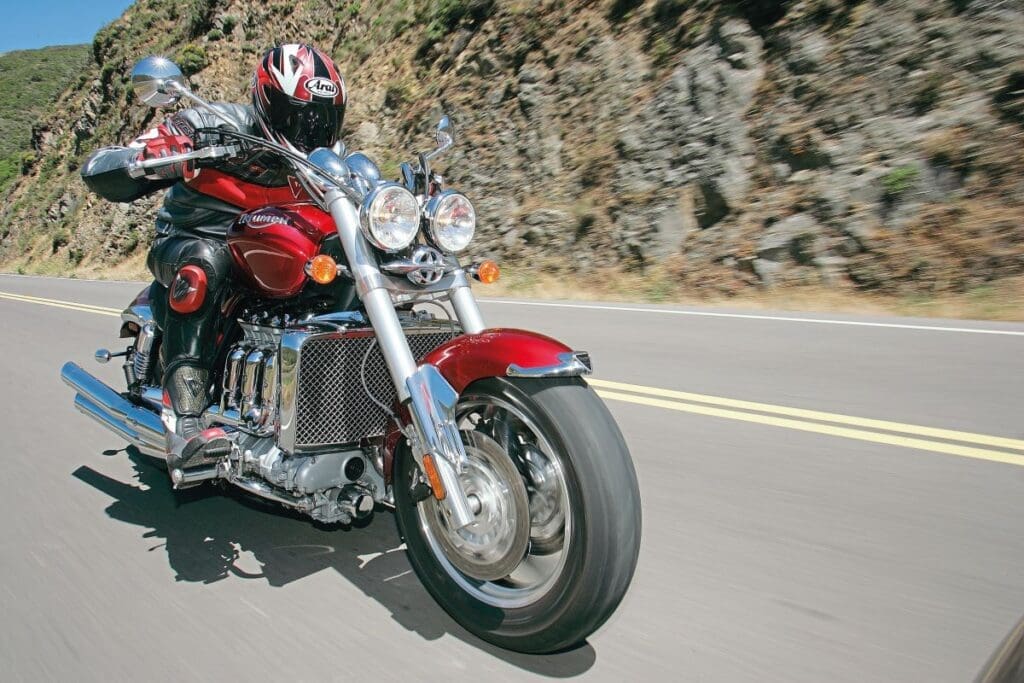
WORDS: BERTIE SIMMONDS
PICS: TRIUMPH UK, BERTIE SIMMONDS, MORTONS ARCHIVE
When you’ve been around the block a bit in the biking world, there are not many machines out there that can intimidate, but there are still a few. Some motorcycles may be so expensive you just worry even throwing a leg over them for fear of scratching a grand’s worth of damage with a mistimed swing of an errant leg… Some may express mechanical malevolence as a result of their performance or wayward reputations. I’m thinking of, perhaps, the Laverda Jota; maybe the early Suzuki GSX-R1100s; the first Honda FireBlade; Suzuki’s TL1000S; something that demands respect from the bike’s performance or horror stories of a bike ‘gone bad’. You know the ones.
Some may be just so HEEUGE, that just climbing aboard feels like scaling the Eiger and that – once you’ve plonked your flag on top – you wonder if riding the thing on little B-roads and attempting a U-turn will be like trying to do a three-point turn in a super-tanker on the Norfolk Broads… I’m thinking of any big full-dress Harley-Davidson tourer, Honda’s GL1800 Gold Wing, and BMW’s big Boxer twin and four (or more) cylinder behemoths.
Enjoy more classic motorcycle reading, Click here to subscribe to one of our leading magazines.
And then there’s the Triumph Rocket III. This doesn’t have a bad image (quite the contrary) but it is BIG and it is POWERFUL and it certainly gets your attention and the attention of anyone who sees you ride it. But let’s start at the beginning – what on earth were Triumph thinking building this bad boy?
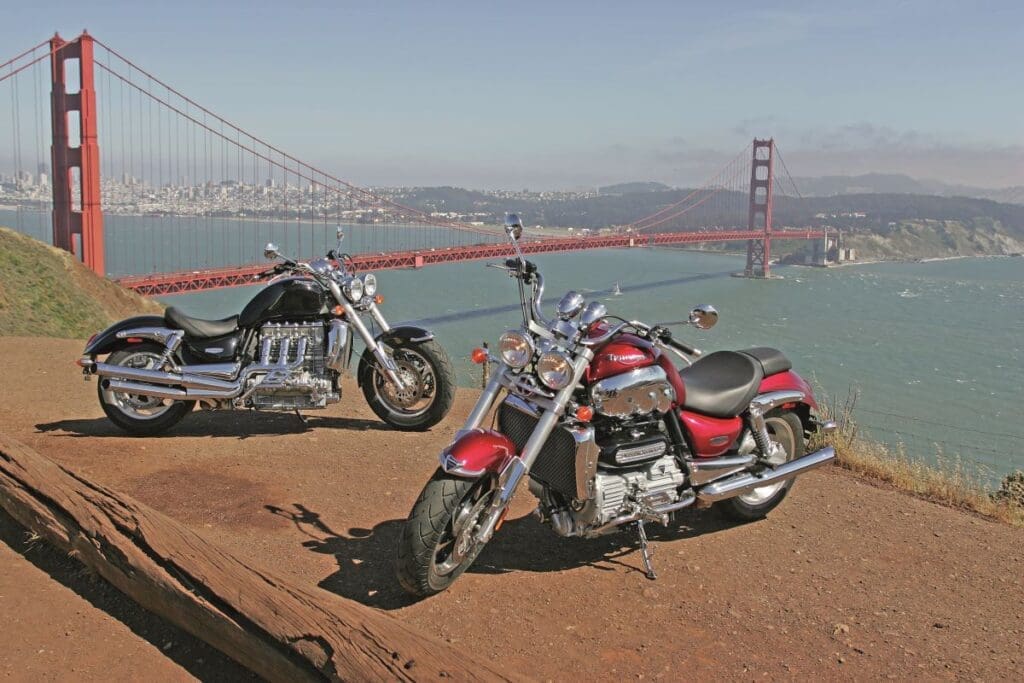
Well, let’s go back to 1998 where there’s a big pow-wow at Triumph in Hinckley. We’re full into the sports-bike craze in the UK but worldwide sales show that 40 per cent of all sales are of cruisers – big cruisers… And most of those sales are in the USA, where they ‘go big’ at every turn. Project C15XB was born – where the ‘15’ suggested a 1500cc capacity to take on the-then Harleys and, of course, Honda’s 1520cc flat-six Valkyrie.
Like any Harley, and the Honda, the design needed to make the motor the star of the show, not just with performance but with the whole look of the bike; it was to be the focal point. Engine layout couldn’t be V-twin (too Harley) and while a bigger bore version of Triumph’s four-cylinder motors was mooted, as was a V6 (too big), instead a three cylinder powerplant was chosen to be mounted longitudinally. Triumph at the time were famed for making sure their bikes handled, so this cruiser would have a 200 rear section back tyre as a minimum requirement, upside-down forks and brakes from their sports machines.
In charge of the overall look was John Mockett, legendary bike designer and the man behind the RD-LC Pro-Am bodywork. With the mighty motor as the centre-piece a number of designs were looked at and focus groups were used to nail down the final look. The final design used the Speed Triple twin headlamps, a two-stacked exhaust system on the right-hand side with a single on the left. A big 25-litre tank was also used to dominate the look of the bike – as well as give around a 160-mile tank range.
While the design was being worked on, things were happening, such as the rumours of the Honda V-twin VTX1800 – meaning the 1500 Triumph sounded a tad weedy. Eventually, like the first FireBlade, it’s thought that the best thing is to shoe-horn the biggest three-cylinder they can into the chassis they have. That meant more than two litres and the project was renamed C20XB. In American speak (cubic inches) two litres was rounded up to become 140 cubic inches, or 2294cc.
This marked the new machine as the largest capacity mass production motorcycle of the time. The crank alone weighed 17.7 kilos, needing a hoist to get it in the motor on the bike’s (unique to the Rocket) production line. The pistons were 101.6mm in diameter (the same as a Dodge Viper of the time) and the bike also had a sports-style ‘stacked’ gearbox to help keep the wheelbase within useable parameters.
Performance was impressive. Ross Clifford was Triumph’s Project and Racing Manager (he’s now Royal Enfield’s man in the USA) and he says: “Originally we wanted 100bhp and 100lb-ft of torque but with the capacity set, the figures we got were around 130-140bhp and 147 for torque – with a really nice flat torque curve. This meant the bike hit 60mph in two seconds and 100 in 7.2. We also estimated you’d be pulling 1.1 and 1.2G when accelerating…” And all delivered in a low-revving style – 90 per cent of max power is available from just 2000rpm and max power and that torque figure is delivered at less than 3000rpm. The redline was set at just 6500rpm… By mid-2003 a year from launch the name Rocket III had been chosen to reflect the Triumph-powered BSA Rocket 3.


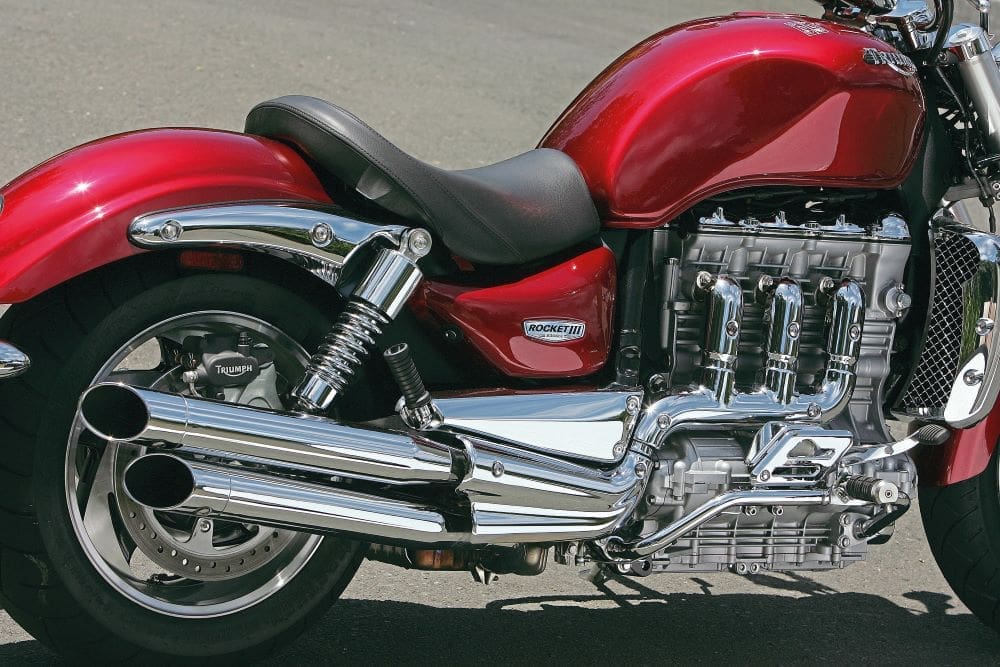
Let’s go ride! Now, when you realise the stats of this bike (970mm wide, 2500mm long) it is huge as you approach it. You can drink in the looks and here’s where I’ve always had a bit of an issue with the original Rocket III. It seems to me to be neither a proper chrome-laden cruiser (there is some on show) nor a brutish, understated power cruiser – although one of the launch colours was ‘Jet Black’ alongside ‘Cardinal Red’. For me, the Speed Triple headlights look good and the motor draws the eye, especially the chrome bits and radiator – but then so does that bulbous 26-litre tank and I’m not convinced. It’s a mildly confusing mix of bulky and svelte. That said, it’s not ‘overdone’; even the ‘ROCKET III 2300cc’ logo isn’t shouting from the side-panel even if the chrome-covered downpipes that exit on the right-hand of the motor are telling you just what sort of engine you’re about to unleash.
Mounting the thing is easy – it’s only a 740mm seat height and it’s a nicely padded seat, too. Being a cruiser kinda tool, the bars are pulled back a tad and the foot-pegs pushed out front. The clocks are a bit busy on the speedo side but as I kick up the side-stand I can start to feel the 350 kilo wet weight. Fire her up and there’s no hint of the madness to come, just a quiet burble. Pull in the light clutch and engage first gear.
As soon as you pull away the kilos melt beneath those huge tyres. Well balanced comes to mind… When you start to accelerate (and you’ll want to) you start to appreciate the recesses on the fuel tank that you can grip as you go for it. We’ve mentioned the output you’ve got here; maybe the 140bhp is now less than 120 at the rear tyre, but it’s still Harley-whopping territory. It’s the delivery which impresses hugely…
Even at the top of the five-speed slick-enough transmission you can trundle along under 2000rpm and know that a crack of the throttle will get a wiggle on – all snatch-free thanks to that excellent fuel-injection system. Using the gear-box properly and the acceleration is something you wouldn’t expect on something this big… this heavy – even if it’s been wound back a bit in the first three gears. It still beggars belief! It’s a genuine 120mph bike – but your neck muscles won’t thank you. Chillax bro’ and just enjoy the away-from-the-lights acceleration delivered through that smooth shaft-drive system.
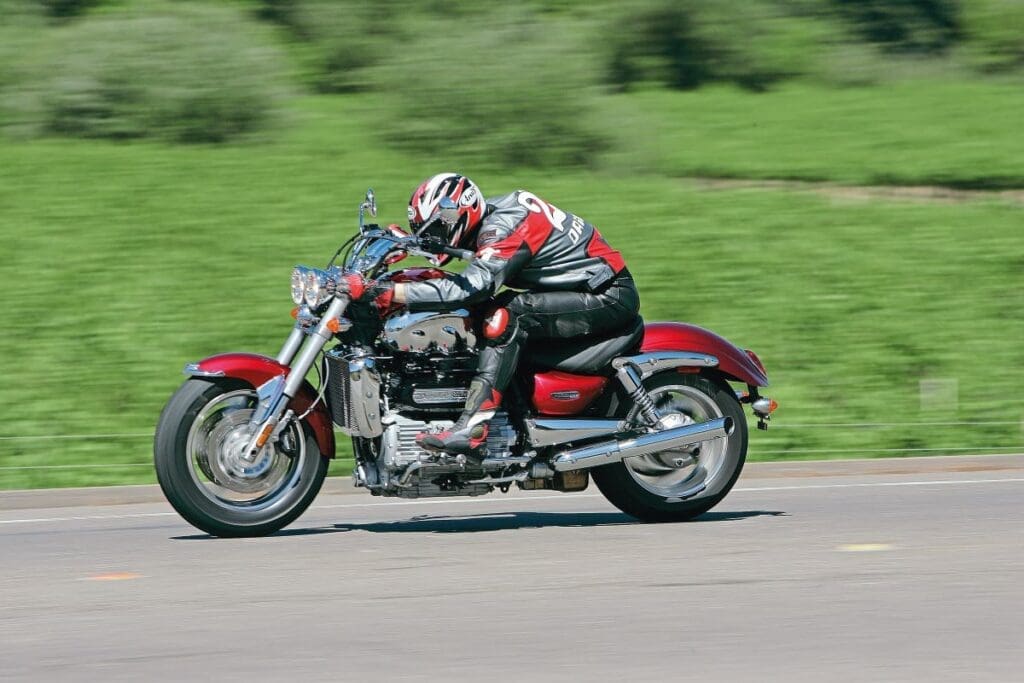
Not that this thing is a straight-line-only machine. Oh no… there’s enough ground clearance (eight inches apparently) to play with. That’s better than scraping things when you even think about a corner as you do on some cruisers. Add in the fact that you’ve got what feels like a low centre of gravity allied to those big front (150/80-17) and 240/50- 16 rear (widest of the time) and you can have fun mushing the bike from side to side. Sure, it’s no sports-bike and you pick your lines as you tune into the long (1695mm wheelbase) chassis: it’s fun.
Suspension, though, can feel crude over the bumpy stuff. While the front 43mm inverted forks (a first for a Triumph) are derived from Kayaba’s sports-bike range they aren’t adjustable. Meanwhile, the twin shocks attached to the double-sided steel swingarm are adjustable only for pre-load. If you hit a bump you’ll feel it right through your backside and that’s the big downside. The seating position not only makes you a bit of an air-brake, it also sees any bump translated through your gluteus maximus – the more maximus you have, the better… From memory, I can say that the bike is okay comfort wise but you will need to get off and stop before that big tank (160-180 miles or more) is emptied.
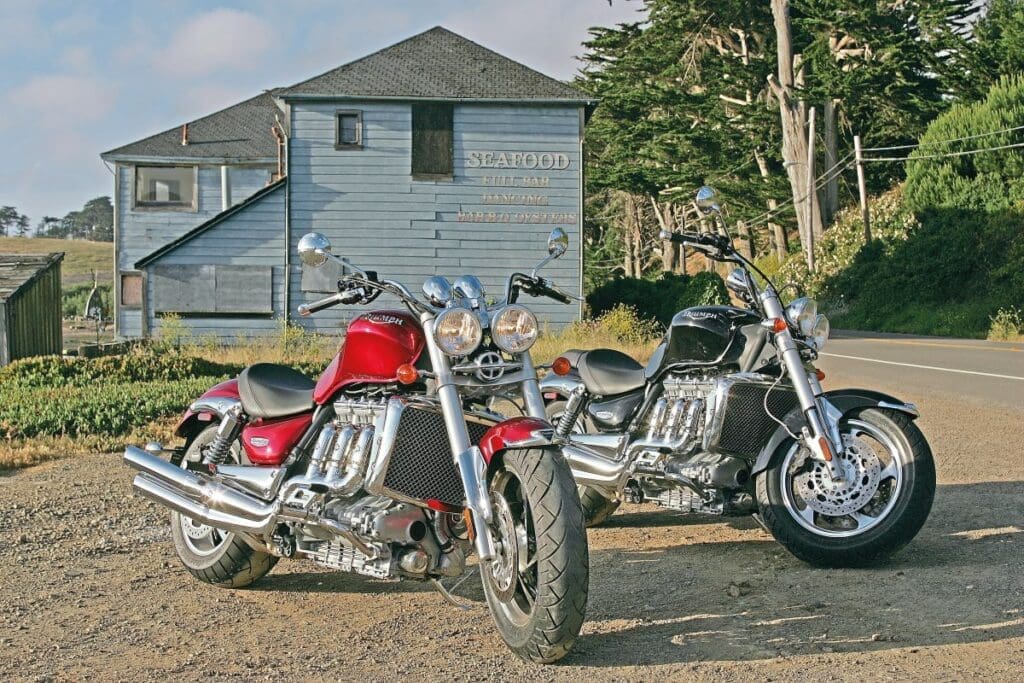
Braking is something that’s better on this than a comparable cruiser from the same decade. The brakes are donated from the Daytona 955i of similar vintage – so that’s twin floating 320mm discs with four-pot calipers, while to the rear is a whopping single 316mm disc with a twin-pot caliper, specifically designed by Brembo for optimum performance. They work and work well – in typical cruiser style, use plenty of boot to get the beast stopped…
When you stop for fuel or a Ginsters, you’ll probably have a small crowd gathered around you and you can regale them with amazing info such as the fact that the Rocket III motor at idle produces more torque than the max listed for the 2004 Triumph Tiger. Maybe one of them will want a lift somewhere but they’ll probably shirk at the removable pillion pad. Better two-up/touring Rockets came later. You’ll want open exhausts, too, because what’s the point of the bite without the bark?
Today, in retrospect, I can say hand on heart that I love the original Rocket III but it’s not without its flaws. While I loved the premise of the bike which was ‘power to the people’, the styling was more ‘Village People’. More so if you bedecked your Rocket III with some of the 51 aftermarket products Triumph produced at the time. Some were useful (screens, oil pressure gauge, exhausts), others were a bit gaudy such as bodywork with ‘tribal’ graphics.
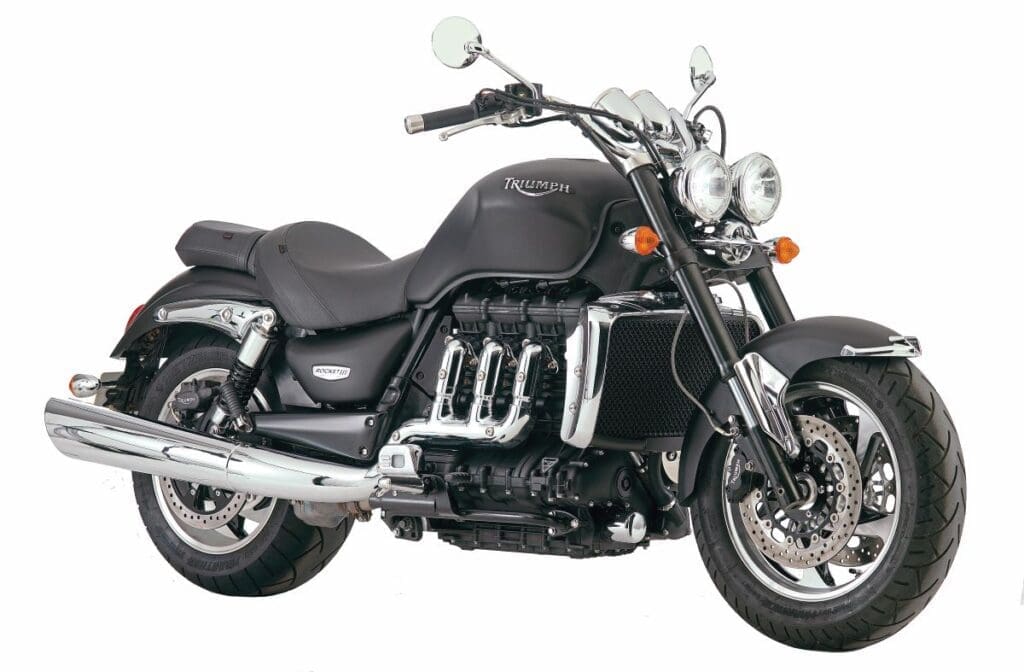
Maybe it was this overall ‘look’ that meant the bike struggled to find its place in the market? Like the Harley-Davidson V-Rod, this was a ‘power cruiser’ which seemed to alienate traditional buyers of the marque and confuse newcomers. The Rocket III did look a little like the big/daft Chevvy V8-powered Boss Hoss Cycles. Then, adding to the confusion early on in the bike’s life there were a number of models of the basic Rocket III. These included 2006’s ‘Classic’ (think more cruiser); 2010’s ‘Roadster’ (think stripped-back original now with 146bhp); 2007’s ‘Tourer’ (basically a Classic with screen/panniers/comfy rear seat and back-rest); and 2008’s Rocket III Touring. This was a more considered Tourer with 180 rear section tyre, 16-inch front, more torque, but power capped to just under 110bhp. It was almost as if the Rocket III was Mr. Benn and every so often it would leave 52 Festive Road to become something else for a short time. From 2019 the Rocket III was replaced by the Rocket 3 (see below).
But let’s concentrate on the launch model. This is still a helluva lot of machine for the mula. Back in 2004 the bike cost £11,990 – a fair saving on a V-Rod which cost between £13-£14k. With two decades behind it, it’s fair to say it’s also a pretty robust bike, but they do need TLC to keep the finish up to a good standard and clutches can fry thanks to the big torque and power outputs. So how much?
Well, we’ve found them for as low as £3800. That’s a steal… power and pose for under four grand. Yes, the original Rocket III is unsure of quite what it is and has its flaws, but for a two-wheeled experience that few other motorcycles can give, it’s also got few peers. And how cool is it that you can tell people your bike has a bigger engine than their family estate car before burning off a sports car away from the lights?
The thoroughly modern ROCKET 3
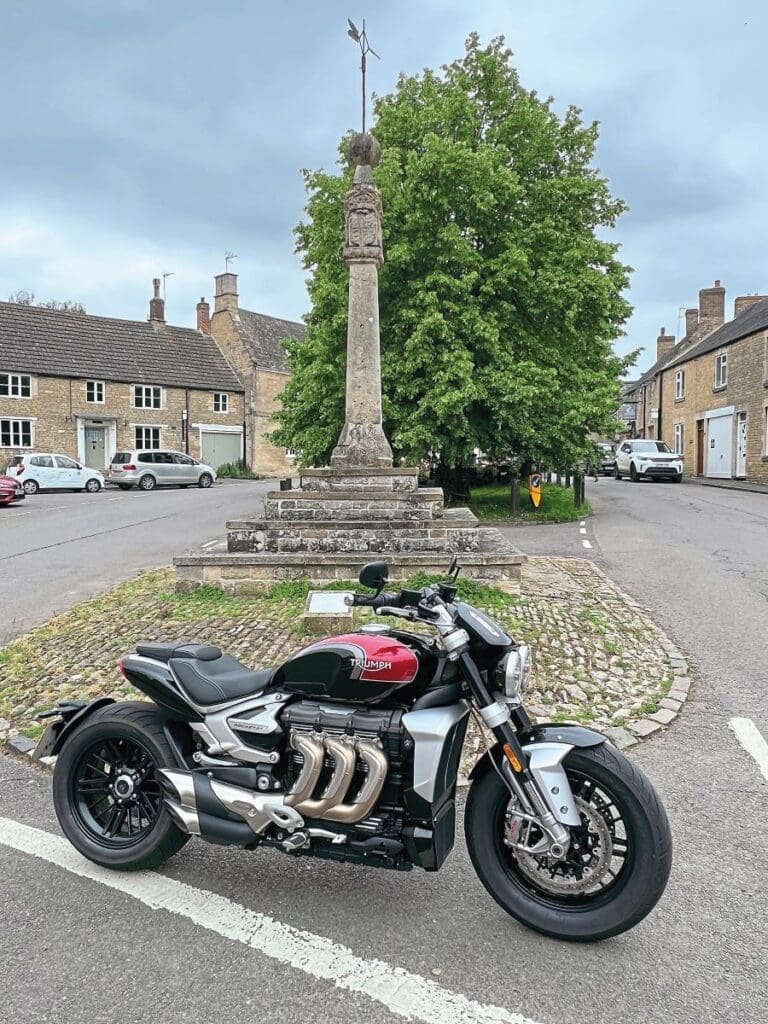
Triumph UK kindly offered me a few days on the latest (well, 2023) Rocket 3, which was nice.
Previously the most modern versions I’d ridden had been a Roadster in 2010 and a Touring in 2012. Since the 2019 relaunch the Rocket 3 range has been the R model – the sportiest of the three, then the GT (tourer) and limited-edition TFC (Triumph Factory Custom). In 2024 you’ve now got the Rocket 3 Storm.
The first thing you’ll notice are the utterly drop-dead gorgeous looks. At last the bike has a look all of its own. The bulbous tank has gone and the bike has a lower, leaner look completely, but still with that bug-headlight stare. Once more the engine is the beloved centre-piece – now boasting 2458cc (150 cubic inches) and an output of 165bhp at 6000rpm and 163lb-ft of torque at 4000rpm. Wow.
And what a cacophony when you start it up: the noise through those side-mounted slash-cut exhausts is addictive. The cans stop short so you can see that big, beautifully exposed rear wheel on the single-sided swingarm – yup the rear is still a 240!
Riding this bike is an experience in itself. The first time I gave it the berries I was mildly disappointed – until I realised I was in ROAD and not SPORT mode. Suddenly you’re throwing all six (slick) gears at the bike and giggling insanely inside your helmet.
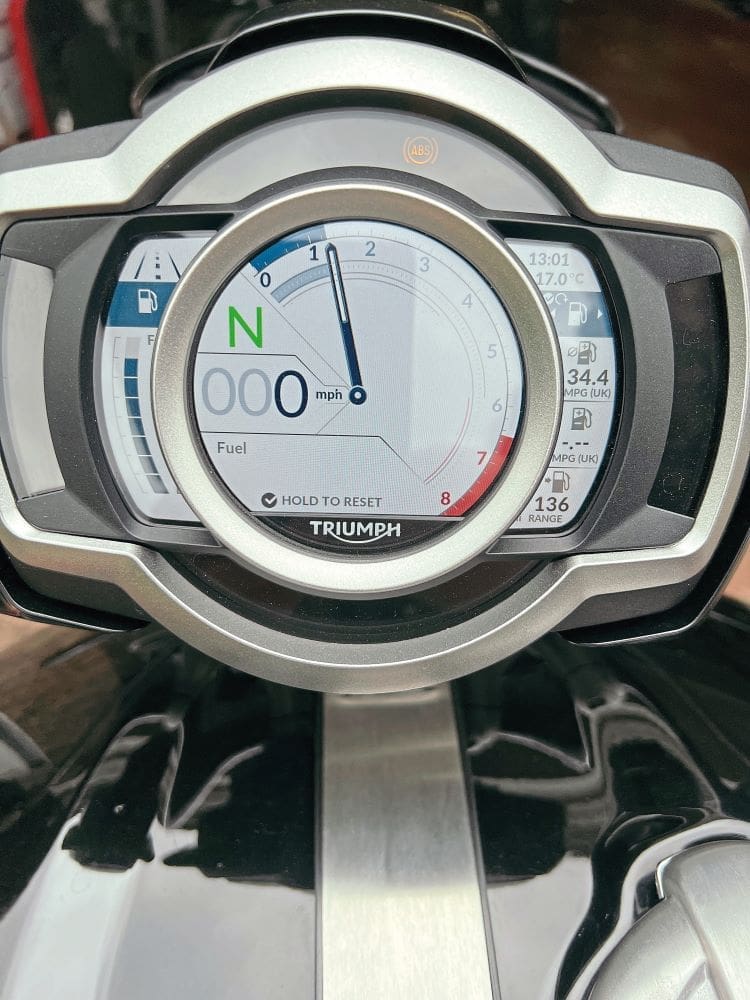
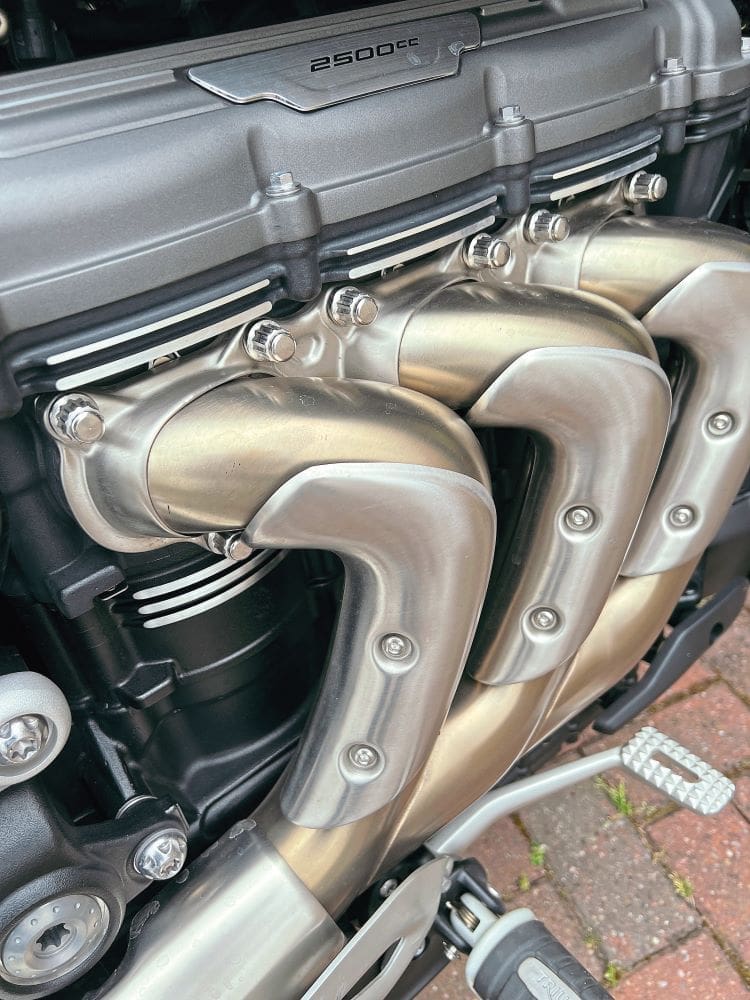
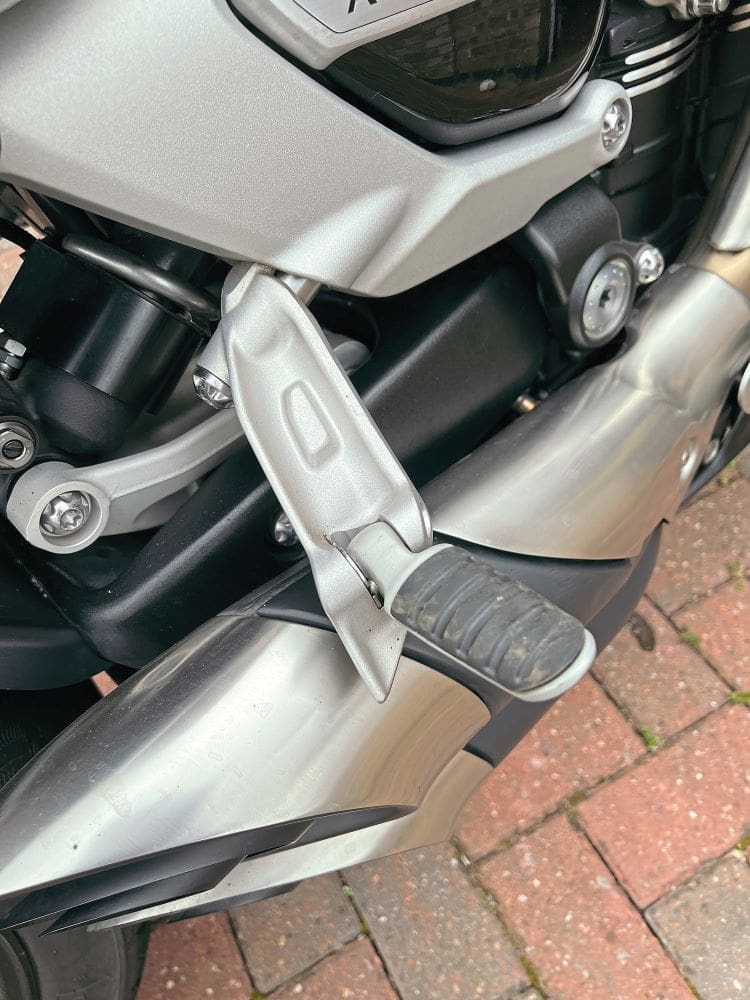
The handling works better than before. The old twin steel tube frame is replaced with a cast aluminium spine frame and attached at either end is modern running gear. Dry weight is now about 30 kilos down on the original. Once more the Rocket 3 can handle, but this one is leagues ahead of the old one. If there’s one criticism it’s that the feeling is still a little harsh for the UK’s pot-holed roads, but at least the 47mm Showa forks have adjustment, as does the mono-shock at the rear. Brakes are immense and a world ahead of the original bike. Big radial Brembo calipers work with 320mm discs. It’s comfortable, too, albeit a bit of a stretch to the bars. The build quality is excellent and there are lots of lovely touches, not least the fold-out pillion pegs.
This bike makes a trundle to the shops an event and it’s the bike the original should have been. Sure, the latest Storm is a shade over £23,000 (the original R was around £19,000) but if I won the lottery one of these would be in my garage. Secondhand they start at around £12k.
www.triumphmotorcycles.co.uk
2004 TRIUMPH ROCKET III
ENGINE
Liquid-cooled longitudinal inline three-cylinder DOHC 12-valves
CAPACITY
2294cc (101.6 x 94.3mm)
COMPRESSION RATIO
8.7 to 1
IGNITION
Digital electronic
CARBURATION
Multipoint sequential
fuel-injection
PEAK POWER
140bhp at 5750rpm
PEAK TORQUE
147lb-ft at 2500rpm
CLUTCH
Wet multi-plate
GEARBOX
Five speed
FINAL DRIVE
Shaft drive
FRAME
Tubular steel twin spine
FRONT SUSPENSION
43mm inverted telescopic fork
REAR SUSPENSION
Steel swingarm with twin shocks with pre-load adjustment
FRONT WHEEL
3.5 x 17, five spoke
REAR WHEEL
7.5 x 16, five spoke
FRONT TYRE
Metzeler 150/80-17
REAR TYRE
Metzeler 240/50-16
FRONT BRAKE
320mm dual discs, four-piston calipers
REAR BRAKE
316mm disc, two-piston caliper
FUEL TANK
25 litres (5.5 gallons
WHEELBASE
1695mm (66.7in)
SEAT HEIGHT
740mm (29in)
RAKE
32 degrees
TRAIL
150mm (5.9in)
WEIGHT
320kg (704lb) dry claimed

